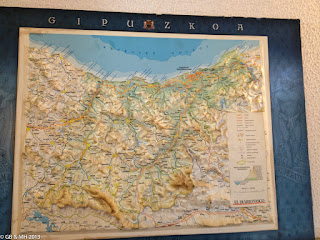“Dos sidras” Billy announced to the man in the purple and red checked shirt behind the bar. We sat on stools at the counter and watched the man grip two tumblers in his left hand. He deftly poured a spout of golden yellow liquid from a green glass bottle that he held more than a meter above.
The cloudy liquid fizzed as it hit the bottom of the glasses at speed from this height. Apparently it is necessary to aerate the dry Basque drink to release its flavours… and make it palatable!
I raised my eyes at this process. The barman, satisfied with his approach, placed the tumblers in a rare empty spot on the counter filled with food platters and glasses of wine. Billy gave a universally accepted nod of the head to the barman.
The barman left us for the moment, and turned to serve the next set of locals who had walked in the door. With the red electronic sign flashing 3deg C outside, Bar Bigarren was full to overflowing.
 |
| Bar Bigarren |
We considered the food options conveniently laid out in front of us at the bar.
The Basque serve a form of tapas called pinxtos – small servings of finger food – that are often sprawled across the bar. A veritable feast of colours and flavours!
 |
| Basque Pinxtos! |
I was keen to avoid the pigs trotters and pointed to the pulpo (octopus) tentacles in paprika threatening to escape the serving plate in front of us. Billy picked out the fried bolas de carne (meat balls) and we were set for the night.
We were planning out the next four days, which we hoped to spend hiking along the Basque coastline. So far, it had been a little difficult to find information and maps, so we had brought a pile of printouts from the internet to mull over.
The most common route from San Sebastian towards Bilbao is to take the Camino del Norte. This is the northern, coastal option for the Camino de Santiago or “Way of Saint James”, an ancient Christian pilgrim route.
From our research, it looked like this route mostly followed roads (granted some of these were ancient roman roads) was inland from the coast and well populated with towns.
We had hoped to camp and wanted to take in the coastal views, so were following up on Grand Recorrido Route 121 spotted on a small scale map we’d used to help plan our Pyrenees hike.
Our maps were scattered over the bartop, a few corners absorbing the spilt remains of someone’s dinner. The barman returned and eyes lit up. He spoke quickly as he posed a question in a thick lisping Spanish accent.
We paused to absorb what he said, then Billy pieced things together enough to respond, “yes, we’re hoping to walk from here to Bilbao, do you know the route?”
“Ah, Costa de Vasco, muy bonito” the man responded, then continued in a torrent of words that gushed along the counter.
We couldn’t understand a word. He pointed at the maps, we pointed at the maps and shuffled pages, trying to understand what he was passionately telling us about.
He kept pointing to a black dashed line on the map that we hadn’t taken much notice of. He was saying something about crossing a border.
Billy finally worked out he was talking about “la frontera”, the boundary between the region of Gipuzkoa (where San Sebastian is located) and Biscay (where Bilbao is located), both within the Basque province of Spain. Did we need our passports? Special permission?
 |
| Gipuzkoa, Basque region |
This was our first lesson in understanding the passion of the Basque people and their rivalry with other regions, even within amongst their own!
Once we had acknowledged the council boundary, the man found his blue, thick-rimed glasses from his pocket and closely studied the coastline on the map.
He tapped his finger on the town of Lekeitio and ramped up the discussion. Hands went flying. A small drip of sweat beaded down his forehead beneath his tight dark curled ringlets. We didn’t know what he was saying.
The man turned to a young blonde woman who had stuck her head through a small side window of the bar that opened out to the street. She was smoking a cigarette and was wrapped in a black fur lined down jacket. He implored her to help us understand.
“Ah, Basque coastline is very dramatic. Here at Lekeitio, they have annual festival with a large bird…how do you say?”.
She flapped. I flapped back.
“Duck?” I tried.
“Si, duck. They cover it in oil and hang it over the ocean. Fishermen jump up to grab it. The last one to hold when the neck breaks wins. I don’t like this.”
“It is an amazing coastline” she continued, “very unique”.
That sounds awful I thought. Perhaps we’ve had a translation mix-up? The story is indeed true. At least these days the duck is already dead!
The excitement at the bar had started to die down. We had enough ideas now, and were convinced that it was worthwhile to head down the coastal path, to discover what inspired the passion in these Basque people at the bar.
No comments:
Post a Comment